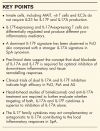Out of the shadow of interleukin-17A: the role of interleukin-17F and other interleukin-17 family cytokines in spondyloarthritis
- PMID: 34001692
- PMCID: PMC8183488
- DOI: 10.1097/BOR.0000000000000805
Out of the shadow of interleukin-17A: the role of interleukin-17F and other interleukin-17 family cytokines in spondyloarthritis
Abstract
Purpose of review: The last decade has witnessed tremendous advances in revealing an important role for the interleukin (IL)-17 cytokine family in the pathogenesis of spondyloarthritis (SpA). Although most attention has been focused on IL-17A, a potential role of other IL-17 family members in inflammation and tissue remodelling is emerging. Herein, I review recent studies covering the role of IL-17B-F cytokines in the pathogenesis of SpA.
Recent findings: Several recent studies provided new insights into the cellular source, regulation and function of IL-17F. IL-17F/IL-17A expression ratio is higher in psoriatic skin compared to SpA synovitis. IL-17F-expressing T cells produce different proinflammatory mediators than IL-17A-expressing cells, and IL-17F and IL-17A signal through different receptor complex. Dual IL-17A and IL-17F neutralization resulted in greater suppression of downstream inflammatory and tissue remodelling responses. Furthermore, there is additional evidence of IL-23-independent IL-17 production. In contrast to IL-17A, IL-17F and IL-17C, which play proinflammatory roles in skin and joint inflammation, an anti-inflammatory function is proposed for IL-17D. An increase in IL-17E is associated with subclinical gut microbiome alterations after anti-IL-17A therapy in SpA patients.
Summary: IL-17 family cytokines may act as agonists or antagonists to IL-17A contributing in concert to local inflammatory responses. Understanding their function and identifying their cellular sources, and molecular mechanisms driving their expression will be the key to designing rational therapies in SpA.
Trial registration: ClinicalTrials.gov NCT03536884.
Copyright © 2021 The Author(s). Published by Wolters Kluwer Health, Inc.
Conflict of interest statement
Figures
Similar articles
-
The paradigm of IL-23-independent production of IL-17F and IL-17A and their role in chronic inflammatory diseases.Front Immunol. 2023 Aug 4;14:1191782. doi: 10.3389/fimmu.2023.1191782. eCollection 2023. Front Immunol. 2023. PMID: 37600764 Free PMC article. Review.
-
Interleukin 17A and IL-17F Expression and Functional Responses in Rheumatoid Arthritis and Peripheral Spondyloarthritis.J Rheumatol. 2020 Nov 1;47(11):1606-1613. doi: 10.3899/jrheum.190571. Epub 2020 Jan 15. J Rheumatol. 2020. PMID: 31941804
-
IL-17 in the immunopathogenesis of spondyloarthritis.Nat Rev Rheumatol. 2018 Aug;14(8):453-466. doi: 10.1038/s41584-018-0044-2. Nat Rev Rheumatol. 2018. PMID: 30006601 Review.
-
Interleukin-17 family cytokines in protective immunity against infections: role of hematopoietic cell-derived and non-hematopoietic cell-derived interleukin-17s.Microbiol Immunol. 2018 Jan;62(1):1-13. doi: 10.1111/1348-0421.12560. Microbiol Immunol. 2018. PMID: 29205464 Review.
-
IL-17B and IL-17C are associated with TNF-alpha production and contribute to the exacerbation of inflammatory arthritis.J Immunol. 2007 Nov 15;179(10):7128-36. doi: 10.4049/jimmunol.179.10.7128. J Immunol. 2007. PMID: 17982105
Cited by
-
Comparative efficacy and safety of bimekizumab in axial spondyloarthritis: a systematic literature review and network meta-analysis.Rheumatology (Oxford). 2024 May 2;63(5):1195-1205. doi: 10.1093/rheumatology/kead598. Rheumatology (Oxford). 2024. PMID: 37947318 Free PMC article.
-
Differentiation and regulation of CD4+ T cell subsets in Parkinson's disease.Cell Mol Life Sci. 2024 Aug 17;81(1):352. doi: 10.1007/s00018-024-05402-0. Cell Mol Life Sci. 2024. PMID: 39153043 Free PMC article. Review.
-
Impact of Adalimumab Treatment on Interleukin-17 and Interleukin-17 Receptor Expression in Skin and Synovium of Psoriatic Arthritis Patients with Mild Psoriasis.Biomedicines. 2022 Jan 29;10(2):324. doi: 10.3390/biomedicines10020324. Biomedicines. 2022. PMID: 35203534 Free PMC article.
-
The paradigm of IL-23-independent production of IL-17F and IL-17A and their role in chronic inflammatory diseases.Front Immunol. 2023 Aug 4;14:1191782. doi: 10.3389/fimmu.2023.1191782. eCollection 2023. Front Immunol. 2023. PMID: 37600764 Free PMC article. Review.
References
-
- Baeten D, Sieper J, Braun J, et al. . Secukinumab, an interleukin-17A inhibitor, in ankylosing spondylitis. N Engl J Med 2015; 373:2534–2548. - PubMed
-
- McInnes IB, Mease PJ, Kirkham B, et al. . Secukinumab, a human antiinterleukin-17A monoclonal antibody, in patients with psoriatic arthritis (FUTURE 2): a randomised, double-blind, placebo-controlled, phase 3 trial. Lancet 2015; 386:1137–1146. - PubMed
-
- Mease PJ, van der Heijde D, Ritchlin CT, et al. . Ixekizumab, an interleukin-17A specific monoclonal antibody, for the treatment of biologic-naive patients with active psoriatic arthritis: results from the 24-week randomised, double-blind, placebo-controlled and active (adalimumab)-controlled period of the phase III trial SPIRIT-P1. Ann Rheum Dis 2017; 76:79–87. - PMC - PubMed
-
- Mease PJ, Genovese MC, Greenwald MW, et al. . Brodalumab, an anti-IL17RA monoclonal antibody, in psoriatic arthritis. N Engl J Med 2014; 370:2295–2306. - PubMed
-
- Mease PJ, McInnes IB, Kirkham B, et al. . Secukinumab inhibition of interleukin-17A in Patients with psoriatic arthritis. N Engl J Med 2015; 373:1329–1339. - PubMed
Publication types
MeSH terms
Substances
Associated data
LinkOut - more resources
Full Text Sources
Other Literature Sources
Research Materials



